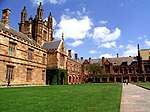Macleay Museum
 Edgeworth David Building that houses the Macleay Museum | |
 | |
Former name | Museum of Antiquities |
|---|---|
| Established | 1887 |
| Dissolved | 22 November 2016 |
| Location | Science Road, The University of Sydney, Camperdown, New South Wales, Australia |
| Coordinates | 33°53′07″S 151°11′17″E / 33.8852°S 151.1881°E |
| Type | Natural history museum |
| Collections |
|
| Collection size | 79,000+ |
| Founder | |
| Director, University Museums | David Ellis (since 2013) |
| Curator |
|
| Architect | George Allen Mansfield |
| Owner | The University of Sydney |
| Website | sydney |
New South Wales Heritage Database (Local Government Register) | |
| Official name | Macleay Museum; Macleay Museum Building, University of Sydney Including Interior |
| Type | Local government heritage (built) |
| Criteria | a., c., d., e., f. |
| Designated | 14 December 2012 |
| Reference no. | I79 |
| Type | Education |
| Category | University |
The Macleay Museum at The University of Sydney, was a natural history museum located on the University's Camperdown campus, in Sydney, New South Wales, Australia. The museum was dissolved in 2016 and upon opening of the Chau Chak Wing Museum in 2020, its collections were amalgamated into it.[1]
The Macleay Museum was added to the City of Sydney local government heritage list on 14 December 2012.[2][3]
History
[edit]The Edgeworth David building in which the museum was housed was built off Science Lane within the Camperdown campus in 1887. The collections were based largely on the efforts and acquisitions of the Macleay family, one of the pre-eminent families in colonial Sydney including Alexander Macleay, William Sharp Macleay and William John Macleay. The zoologist and collector George Masters served as curator until 1912.[4]
Collection
[edit]The strengths of the collection, now part of the Sydney University Museums, were in entomology, ethnography, scientific instruments, and historic photographs. Many of the biological specimens in the collection represented rare or extinct species, while some of the specimens have historic and cultural value[5] as they were collected by explorers like Charles Darwin and Nicholas Miklouho-Maclay.
The George Masters Exhibition Space of the museum was devoted to temporary exhibitions. Overall, the museum housed one of the most important natural history and ethnography collections in Australia,[citation needed] surpassed in Sydney only by the Australian Museum.
Gallery
[edit]-
Inside the Macleay Museum
See also
[edit]References
[edit]- ^ "Chau Chak Wing Museum" (Press release). The University of Sydney. Retrieved 9 January 2019.
- ^ "Macleay Museum Building, University of Sydney Including Interior". New South Wales Heritage Database. Office of Environment & Heritage. Retrieved 2 January 2020.
- ^ "Macleay Museum". New South Wales Heritage Database. Office of Environment & Heritage. Retrieved 1 January 2020.
- ^ Whitley, G. P. "George Masters (1837–1912)". Masters, George (1837–1912). National Centre of Biography, Australian National University. Retrieved 30 June 2018.
{{cite book}}:|website=ignored (help) - ^ "Macleay Museum" (video (6:35 mins) and transcript). Catalyst. Australia: Australian Broadcasting Corporation. 12 June 2008. ABC TV. Retrieved 2 January 2019.
External links
[edit]- University of Sydney buildings
- Museums in Sydney
- Natural history museums in Australia
- Buildings and structures completed in 1887
- University museums in Australia
- 1887 establishments in Australia
- George Allen Mansfield buildings
- Museums established in 1887
- 2016 disestablishments in Australia
- Defunct museums in Australia
- Museums disestablished in 2016
- Macleay family




